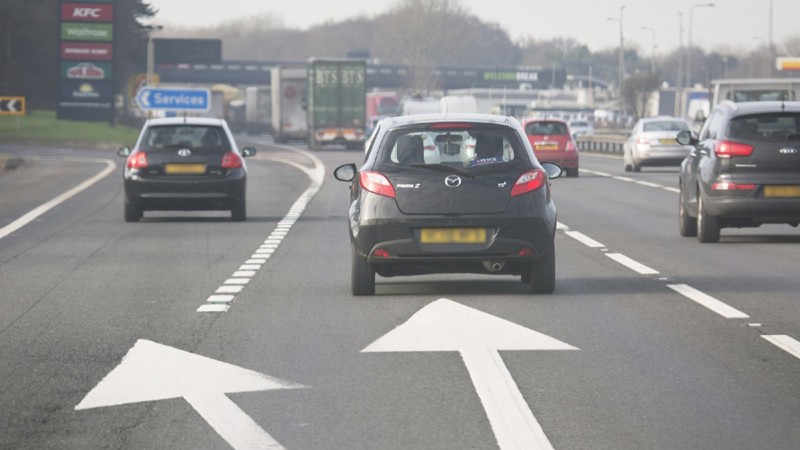Driving on motorways
Whatever part of National Highways' network you’re driving on, we want you to stay safe and know what to do if anything goes wrong. Our videos explain the main features of smart motorways, and we provide advice and guidance on safer driving and what to do in an emergency.

Know when you're driving on a smart motorway
Around 10 per cent of the motorway network is now made up of smart motorways. So it's important to be able to recognise their features and how they work together.
How do smart motorways work?
There are a number of elements which work together to give you a better, more reliable journey.
Our 3 minute film shows how to recognise when you're on a smart motorway, takes you through their features and explains how they help you with your journey.
What does the Red X sign mean?
What do the traffic signs and signals mean?
Go left, get safe, get help
If your vehicle develops a problem, or if you see a red or amber warning light on your vehicle’s dashboard, leave the carriageway at the next exit or pull into a service area if possible.
Do not stop in a live lane unless absolutely necessary.
More advice can be found in Rules 275 to 279 of the Highway Code.
Communicating your location to the emergency services
eCall: Press the eCall SOS button if your vehicle has one.
App: Use a mobile telephone mapping application.
Marker post or driver location sign: Quote the numbers and letters on marker posts or driver location signs which are located along the edge of the road.
If you're involved in an incident or collision, or stop to give assistance, please refer to Rule 283 of the Highway Code.
Disabled drivers
If you have a disability that prevents you from following the above advice, you should:
- switch on your hazard warning lights
- stay in your vehicle and keep your seat belt on
- call 999 immediately and ask for the police. Alternatively, press your SOS button if your vehicle has one and ask for the police.
If you're deaf, hard of hearing or speech impaired, it's recommended that you register for the 999 text service before making a journey.
If you have a hearing, speech or physical impairment text us on 0738 028 3600 for roadside assistance.
Let the operator know if you're disabled and/or a vulnerable motorist - such as an older person or travelling alone.
We also offer British Sign Language users the SignLive service for getting in touch with our customer contact centre. Both are available 24 hours a day, every day of the year.
View our breakdowns advice in British Sign Language video
Motorcyclists
Specific guidance for motorcyclists is available on the Driver & Vehicle Standards Agency's website.
What if I break down on a motorway?
What if I break down in a 'live' lane?
Take care when you rejoin the motorway
Do not exit an emergency area without speaking to National Highways first. We can set signs and warn approaching traffic that you're about to exit an emergency area. We can even close the lane to help you rejoin the motorway if required.
Get back on the road safely from the hard shoulder. Build up speed, use your indicators and watch for a gap in the traffic to rejoin the carriageway safely. Be aware that other vehicles may be stationary on the hard shoulder ahead of you.
Help protect yourself and other drivers
Stay within the speed limit and keep left unless you’re overtaking. This helps to keep you and other road users safe, and to keep traffic flowing as smoothly as possible.
Plan ahead. Check that your vehicle is safe and roadworthy, and that you have enough fuel for your journey. Remember to plan for breaks and don’t drive when you’re tired.
If you or anyone in your vehicle is unable to follow our breakdowns advice for any reason, stay in your vehicle, keep your seatbelts and hazard warning lights on and call 999 immediately.
Don't stop to assist another vehicle that has broken down or been involved in a collision. You may feel you want to help, but it's safer to call National Highways, or if there is an immediate risk to life call 999.
Keep the following items in the car if you can:
- Warm clothes
- Hi-vis jacket
- A torch
- Breakdown cover details
Make sure you have these items with you before you set off on a long journey:
- Any medication you need
- Charged mobile phone
- Food and water
Hidden Disabilities Sunflower for your vehicle
We've teamed up with Hidden Disabilities Sunflower to create a free Sunflower for your vehicle. Displaying the Sunflower indicates that you have an non-visible disability, and may need additional support from traffic officers and others. It means you’ll get the help you need if you break down on the motorway.
Take a road trip with Suzi and Ortis
TV presenters Suzi Perry and Ortis Deley take you on a road trip along a smart motorway, explaining the system and key information that drivers need to know
Watch the full film here (12min)